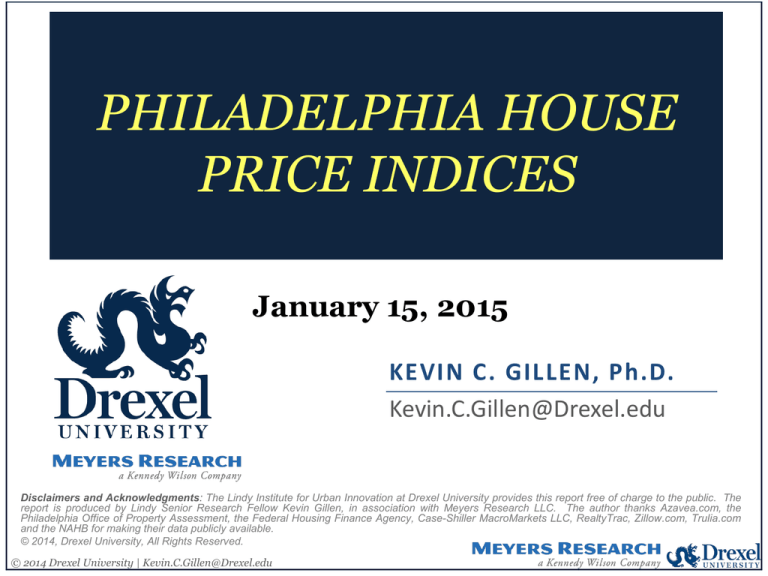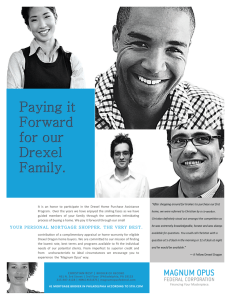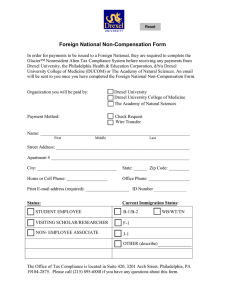
PHILADELPHIA HOUSE
PRICE INDICES
January 15, 2015
KEVIN C. GILLEN, Ph.D.
Kevin.C.Gillen@Drexel.edu
Disclaimers and Acknowledgments: The Lindy Institute for Urban Innovation at Drexel University provides this report free of charge to the public. The
report is produced by Lindy Senior Research Fellow Kevin Gillen, in association with Meyers Research LLC. The author thanks Azavea.com, the
Philadelphia Office of Property Assessment, the Federal Housing Finance Agency, Case-Shiller MacroMarkets LLC, RealtyTrac, Zillow.com, Trulia.com
and the NAHB for making their data publicly available.
© 2014, Drexel University, All Rights Reserved.
© 2014 Drexel University | Kevin.C.Gillen@Drexel.edu
House Price Indices 1980-2014: 1980Q1=100
Philadelphia County v. Philadelphia MSA and U.S. Average
600.0
550.0
Phila. County*
Phila. MSA**
500.0
U.S. Avg.**
450.0
400.0
350.0
300.0
250.0
200.0
150.0
Q4
100.0
**Courtesy of the Federal Housing Finance Agency (FHFA).
HPIs are available through 2014Q3 only.
© 2014 Drexel University | Kevin.C.Gillen@Drexel.edu “MSA”=Metropolitan Statistical Area, which is the entire 9-county region.
* Empirically estimated by Kevin C. Gillen, Ph.D.
Total House Price Appreciation Rates by Geographic Market
Period
Philadelphia
County*
Philadelphia
MSA**
U.S.A.**
34-Year
141.3%
169.9%
126.2%
10-Year
12.2%
24.6%
9.4%
1-Year
5.1%
2.9%
4.4%
1-Quarter
0.8%
2.6%
0.9%
*Empirically estimated by Kevin C. Gillen Ph.D.
**Source: U.S. Federal Housing Finance Agency (FHFA). These numbers are through
2014Q3 only. “MSA”=“Metropolitan Statistical Area”, which is the entire 10-county region.
© 2014 Drexel University | Kevin.C.Gillen@Drexel.edu
House Price Appreciation 1987-2014:
Philadelphia v. 10-City Composite
390
10-City Composite*
340
Philadelphia
290
% Change
10-City
1998 to Peak: +173%
From Peak:
-17%
Philadelphia
+136%
-12%
240
190
140
*Source: S&P/Case-Shiller. The 10-City Composite index includes Boston, Chicago, Denver, Las Vegas, Los Angeles,
Miami, New York, San Diego, San Francisco, and Washington, DC. It does not include Philadelphia.
© 2014 Drexel University | Kevin.C.Gillen@Drexel.edu
2014
2013
2012
2011
2010
2009
2008
2007
2006
2005
2004
2003
2002
2001
2000
1999
1998
1997
1996
1995
1994
1993
1992
1991
1990
1989
1988
1987
90
Philadelphia House Price Indices by Neighborhood: 1980-2014
1980Q1=100
800.0
700.0
CtrCity/Fairmount
Kensington/Frankford
Lower NE Phila.
600.0
North Phila.
NW Phila.
South Phila.
500.0
Univ. City
Upper NE Phila.
West Phila.
400.0
300.0
200.0
Q4
100.0
* All indices empirically estimated by Kevin C. Gillen, Ph.D.
© 2014 Drexel University | Kevin.C.Gillen@Drexel.edu
Philadelphia House Price Appreciation Rates by Neighborhood
Period
Center
City/
Fairmount
Lower
NE
Phila.
Kensington
/Frankford
34-year
161.7%
155.0%
10-year
9.7%
25.7%
7.0%
30.4%
6.7%
48.5%
4.8%
13.8% 37.9%
1-Year
1.0%
4.3%
1.7%
6.6%
-3.0%
5.3%
0.7%
-0.5%
5.8%
1-Quarter
-2.7%
2.1%
-1.6%
0.9%
-1.9%
-1.8%
-0.9%
-0.8%
2.3%
North
Phila.
NW
Phila.
South
Phila.
Univ.
City
Upper
NE
Phila.
127.6% 156.9% 166.8% 191.7% 168.9% 162.4% 156.9%
This table gives the total % change in house prices by neighborhood, through 2014 Q4, from
different starting points in time.
© 2014 Drexel University | Kevin.C.Gillen@Drexel.edu
West
Phila.
Philadelphia Submarket Boundaries
© 2014 Drexel University | Kevin.C.Gillen@Drexel.edu
Median Philadelphia House Price v. Indexed Philadelphia House Price
1980-2014
$140,000
$120,000
Median Price
Indexed Price*
$100,000
$80,000
$60,000
$40,000
$20,000
* Empirically estimated by Kevin C. Gillen, PhD
© 2014 Drexel University | Kevin.C.Gillen@Drexel.edu
2014
2013
2012
2011
2010
2009
2008
2007
2006
2005
2004
2003
2002
2001
2000
1999
1998
1997
1996
1995
1994
1993
1992
1991
1990
1989
1988
1987
1986
1985
1984
1983
1982
1981
$0
1980
Q4
Average House Price Minus Median House Price: 1980-2014
$45,000
$40,000
$35,000
$30,000
$25,000
$20,000
$15,000
$10,000
$5,000
© 2014 Drexel University | Kevin.C.Gillen@Drexel.edu
2014
2013
2012
2011
2010
2009
2008
2007
2006
2005
2004
2003
2002
2001
2000
1999
1998
1997
1996
1995
1994
1993
1992
1991
1990
1989
1988
1987
1986
1985
1984
1983
1982
1981
1980
$0
Number of Philadelphia House Sales* per Quarter: 1980-2014
8,000
Q1
7,000
Q2
Q3
6,000
Q4
5,000
4,000
Qtly. Average
3,000
2,000
1,000
0
2014
2013
2012
2011
2010
2009
2008
2007
2006
2005
2004
2003
2002
2001
2000
1999
1998
1997
1996
1995
1994
1993
1992
1991
1990
1989
1988
1987
1986
1985
1984
1983
1982
1981
1980
*Only arms-length transactions between private sector entities were included in these numbers.
© 2014 Drexel University | Kevin.C.Gillen@Drexel.edu
Number of Philadelphia Home Sales* per Quarter
with Price>=$1 Million: 1997-2014
30
Q1
25
Q2
Q3
20
Q4
15
10
Qtly. Average
5
0
1997
1998
1999
2000
2001
2002
2003
2004
2005
2006
2007
*Only arms-length transactions between private sector entities were included in these numbers.
© 2014 Drexel University | Kevin.C.Gillen@Drexel.edu
2008
2009
2010
2011
2012
2013
2014
Philadelphia House Sales in 2014 Q4
© 2014 Drexel University | Kevin.C.Gillen@Drexel.edu
Center City House Sales in 2014 Q4
© 2014 Drexel University | Kevin.C.Gillen@Drexel.edu
South Philadelphia House Sales in 2014 Q4
© 2014 Drexel University | Kevin.C.Gillen@Drexel.edu
Kensington/Frankford House Sales in 2014 Q4
© 2014 Drexel University | Kevin.C.Gillen@Drexel.edu
West Philadelphia House Sales in 2014 Q4
© 2014 Drexel University | Kevin.C.Gillen@Drexel.edu
North Philadelphia House Sales in 2014 Q4
© 2014 Drexel University | Kevin.C.Gillen@Drexel.edu
Northwest Philadelphia House Sales in 2014 Q4
© 2014 Drexel University | Kevin.C.Gillen@Drexel.edu
Northeast Philadelphia House Sales in 2014 Q4
© 2014 Drexel University | Kevin.C.Gillen@Drexel.edu
2014 Q4 House Price Rate of Change by Neighborhood
Upper NE Phila: -0.8%
North Phila: +0.9%
NW Phila: -1.9%
Univ. City: -0.9%
Lower NE Phila: -1.6%
Kensington/Frankford: +2.1%
West Phila: +2.3%
Center City/Fairmount: -2.7%
South Phila: -1.8%
Note: Each neighborhood is extruded by its average change in house values during 2014 Q4
in order to reflect its growth (or depreciation) rate relative to other neighborhoods.
© 2014 Drexel University | Kevin.C.Gillen@Drexel.edu
+$1 Million Dollar House Sales in 2014 Q4
© 2014 Drexel University | Kevin.C.Gillen@Drexel.edu
Address
520 DELANCEY ST
1338 LOMBARD ST
215 S 09TH ST
507 S PHILIP ST
42 W BELLS MILL RD
2412 SPRUCE ST
8106 SEMINOLE AVE
146 BREAD ST
318 FITZWATER ST
460 W CHESTNUT H AVE
227 DELANCEY ST
1008 N 04TH ST
2319 DELANCEY ST
1729 PINE ST
330 SPRUCE ST
2037 SPRUCE ST
341 S 18TH ST
1814 DELANCEY PL
259 S 04TH ST
Price
Price/SqFt
$1,000,000
$313
$1,000,000
$87
$1,100,000
$388
$1,125,000
$414
$1,130,000
$155
$1,171,500
$414
$1,222,500
$180
$1,250,000
$393
$1,300,000
$334
$1,300,000
$158
$1,368,000
$542
$1,400,000
$452
$1,425,000
$358
$1,485,000
$312
$1,550,000
$361
$1,679,000
$361
$1,762,500
$430
$2,100,000
$490
$2,450,000
$547
Philadelphia House Price Diffusion Index
500.0
450.0
200%
Philadelphia HPI
Diffusion Index
150%
400.0
100%
HPI: 1980Q1=100
350.0
50%
300.0
250.0
0%
200.0
-50%
150.0
-100%
100.0
50.0
The diffusion index measures how varied the direction of house price changes are across Philadelphia
neighborhoods. It is computed as the percent difference between the number of neighborhoods in which
prices rose in a given quarter, and the number of neighborhoods in which prices fell. A value of -100%
indicates that prices fell in all neighborhoods in a given quarter, while a value of +100% indicates that
prices rose in all neighborhoods. A value of 0% indicates that house price changes were evenly split
between increases and decreases, across neighborhoods. Diffusion indexes are commonly used in
financial economics as a leading indicator of turning points in a market's direction.
-200%
1980
1981
1982
1983
1984
1985
1986
1987
1988
1989
1990
1991
1992
1993
1994
1995
1996
1997
1998
1999
2000
2001
2002
2003
2004
2005
2006
2007
2008
2009
2010
2011
2012
2013
2014
0.0
-150%
© 2014 Drexel University | Kevin.C.Gillen@Drexel.edu
Philadelphia House Prices: Declines v. House Price Index
500.0
450.0
400.0
300.0
Pct. Declining
Philadelphia HPI
This chart compares the
Philadelphia House Price
Index (in red) to the
percent of Philadelphia
neighborhoods that
experienced house price
declines (in blue) , in each
quarter from 1980-2014.
90%
80%
70%
60%
50%
200.0
40%
150.0
30%
100.0
20%
50.0
10%
0.0
0%
1980
1981
1982
1983
1984
1985
1986
1987
1988
1989
1990
1991
1992
1993
1994
1995
1996
1997
1998
1999
2000
2001
2002
2003
2004
2005
2006
2007
2008
2009
2010
2011
2012
2013
2014
250.0
© 2014 Drexel University | Kevin.C.Gillen@Drexel.edu
% Declining
HPI: 1980Q1=100
350.0
100%
Dispersion Index of Philadelphia Housing
6.00%
The Dispersion Index measures how varied house price changes are
across the city's neighborhoods. It is computed as the standard
deviation of quarterly house prices changes across submarkets.
High values of the index imply large variation in house price changes
between different neighborhods, while low values imply that house
price changes are relatively the same across the city.
5.00%
4.00%
3.00%
2.00%
1.00%
1980
1981
1982
1983
1984
1985
1986
1987
1988
1989
1990
1991
1992
1993
1994
1995
1996
1997
1998
1999
2000
2001
2002
2003
2004
2005
2006
2007
2008
2009
2010
2011
2012
2013
2014
0.00%
© 2014 Drexel University | Kevin.C.Gillen@Drexel.edu
Philadelphia Housing Affordability* Index: 1980-2014
3.50
3.25
3.00
2.75
2.50
2.25
2.00
1.75
1.50
1.25
*Affordability is measured as the ratio of the
median Philadelphia house price to the median
Philadelphia household income. High values of
the index mean that housing has become less
affordable to the average Philadelphian.
Contact kevin.c.gillen@drexel.edu for details.
1.00
0.75
© 2014 Drexel University | Kevin.C.Gillen@Drexel.edu
2014
2013
2012
2011
2010
2009
2008
2007
2006
2005
2004
2003
2002
2001
2000
1999
1998
1997
1996
1995
1994
1993
1992
1991
1990
1989
1988
1987
1986
1985
1984
1983
1982
1981
1980
0.50
Average House Price-to-Rent Ratios*: 1980-2014
Philadelphia v. U.S.
15.0
14.0
13.0
U.S.
12.0
Philadelphia
11.0
10.0
9.0
8.0
7.0
6.0
5.0
4.0
© 2014 Drexel University | Kevin.C.Gillen@Drexel.edu
*Computed by taking the ratio of average house
price to the average annual rent of a comparable
housing unit. The P/R ratio is to real estate what
the P/E ratio is to other assets. Contact
Kevin.C.Gillen@Drexel.edu for further details.
Inflation-Adjusted* Philadelphia House Price Index 1980-2014
1980Q1=100
200.0
180.0
160.0
140.0
120.0
100.0
80.0
Linear Trendline
60.0
40.0
20.0
0.0
Source: US Bureau of Labor Statistics
© 2014 Drexel University | Kevin.C.Gillen@Drexel.edu
*The empirically estimated house price index is deflated
by the rate of inflation over time, using the national
Consumer Price Index as the proxy for the national rate
of inflation. This procedure converts the house price
index from "nominal" to "real" terms, and thus shows
house price changes net of general inflation.
Philadelphia Houses Listed For Sale: Inventory v. Absorption Rate
14,000
30%
# Houses Listed For Sale
% Absorbed
25%
10,000
20%
8,000
15%
6,000
10%
4,000
5%
2,000
0
“%Absorbed” is defined as the percent of homes listed for sale
in a given month that also sold in that same month.
© 2014 Drexel University | Kevin.C.Gillen@Drexel.edu
0%
Source: Trend MLS
%Absorbed = (#Sales/#Listings)
# Homes Listed "For Sale"
12,000
Average Days-on-Market* for Philadelphia Homes
100
90
# of Days
80
70
60
50
*Days-on-Market (DOM) is the
average number of days it takes
for a listed house to sell.
40
30
Source: Trend MLS
© 2014 Drexel University | Kevin.C.Gillen@Drexel.edu
Index of Homebuilder Sentiment: 1985-2014
(Seasonally Adjusted)
90
National
80
Northeast
70
60
50
40
30
The Index represents the current sentiment of
U.S. homebuilders. The index is computed
via a regular monthly survey of homebuilders.
An index value above 50 indicates that more
builder are optimistic than pessimistic, while
an index value below 50 indicates that more
builders are pessimistic than optimistic.
20
10
Source: National Assoc. of Homebuilders (NAHB)/Wells Fargo
© 2014 Drexel University | Kevin.C.Gillen@Drexel.edu
2014
2013
2012
2011
2010
2009
2008
2007
2006
2005
2004
2003
2002
2001
2000
1999
1998
1997
1996
1995
1994
1993
1992
1991
1990
1989
1988
1987
1986
1985
0
Philadelphia Stock Exchange Housing Sector Index: 2002-2014
$300
$250
$200
$150
$100
$50
The PHLX Housing Sector Index is a modified capweighted index composed of 20 companies whose
primary lines of business are directly associated with the
U.S. housing construction market. The index composition
encompasses residential builders, suppliers of aggregate,
lumber and other construction materials, manufactured
housing and mortgage insurers.
Note: the index underwent a
significant rebalancing in
January of 2006.
2002
2002
2003
2003
2003
2003
2004
2004
2004
2004
2005
2005
2005
2005
2006
2006
2006
2006
2007
2007
2007
2007
2008
2008
2008
2008
2009
2009
2009
2010
2010
2010
2010
2011
2011
2011
2011
2012
2012
2012
2012
2013
2013
2013
2013
2014
2014
2014
2014
$0
Source: finance.yahoo.com
© 2014 Drexel University | Kevin.C.Gillen@Drexel.edu
Philadelphia House Price Index and 1-Year Forecast
Although Zillow still rates the Philadelphia housing market as “cool”, it is currently
forecasting Philadelphia’s house prices to rise an average of 3.4% over the next year,
which is a significant increase over its previous forecast of 0.5%.
Source: http://www.zillow.com/philadelphia-pa/home-values/
© 2014 Drexel University | Kevin.C.Gillen@Drexel.edu



